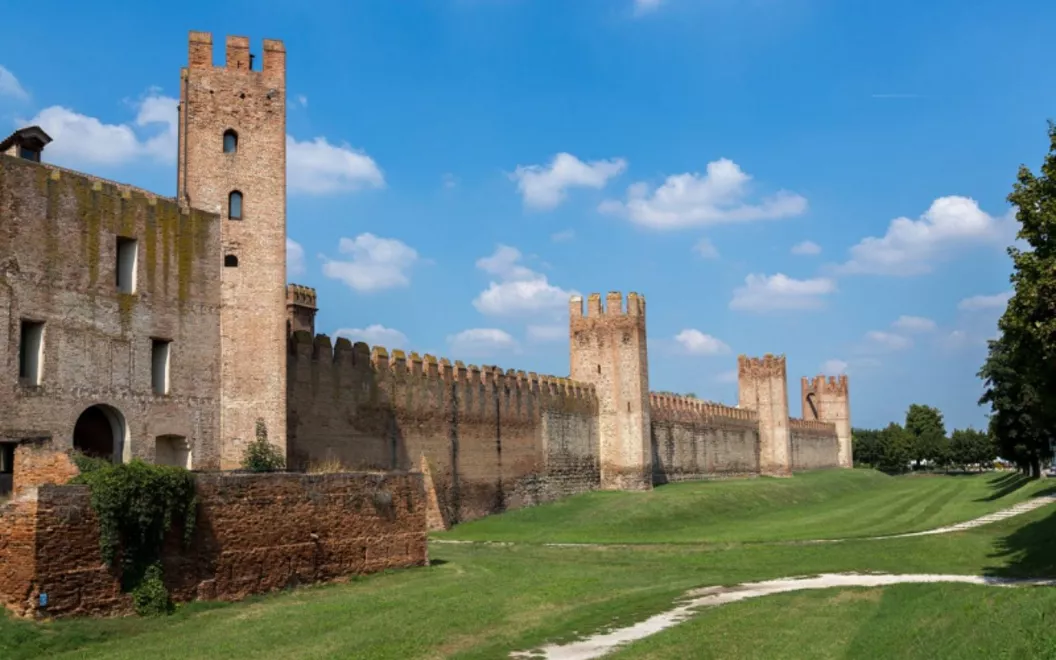Arquà Petrarca: the Poet's Retreat

Arquà Petrarca is a medieval jewel set in the Southern Euganean Hills that will immediately win you over with its timeless charm. Its name derives from the Latin Arquata montium ('ring of mountains') because it lies on the slopes of two hills. Walking up from the car park, you will find yourself in Piazza Roma, with the parvis of the Church of St Maria Assunta, at the centre of which is the funeral monument of Francesco Petrarca, in red Verona marble. Walk along Via Roma, past workshops and other buildings from the 13th and 14th centuries, until you reach Villa Alessi, the former seat of the bishops, which now hosts events and concerts. In St Mark's Square we find theOratory of the Holy Trinity (already existing in 1181), where Petrarch used to go to pray. Past the square and the Venetian lion that dominates it from above, you reach the house that was inhabited by the Poet from 1370 to 1374. The building can be visited and houses a permanent exhibition on the author. From its window, you will admire the breathtaking view of the Euganean Hills, and probably never want to leave.
Monselice, under the gaze of the Rocca

If you find yourself in the beautiful town of Monselice, the first recommended stop is the main square: Piazza Mazzini, which houses most of the most important monuments: the Civic Tower, the Cini Castle, the Palazzo del Monte di Pietà with its Loggetta, and the Complesso monumentale di San Paolo, home to the City Museum. The latter is an essential stop for those who want to learn about the history and transformations of Monselice from the Roman Age to the 20th century. Walking through the pretty streets of the centre, in addition to shops with charming shop windows, wine bars and bars where you can stop for a spritz, you will discover unique views: cobbled streets, ancient stone buildings and the unmistakable backdrop of the hills. But the most engaging route in every respect is that of the 'Seven Churches'. A good stride and comfortable shoes is all you need, as the route is sloping. The Jubilee Sanctuary of the Seven Churches is a small pilgrimage on the slopes of the Colle della Rocca that runs from the Pieve di Santa Giustina, the old cathedral, to theOratorio di San Giorgio and Villa Duodo. The Mastio Federiciano, better known as Rocca di Monselice, is located on top of the same hill and is a trachyte structure built in 1239 as a defensive tool by Emperor Frederick II of Swabia, the infamous 'Stupor Mundi'. The great commemoration called Giostra della Rocca is dedicated to this historical period, a great event that returns every year in September with parades in medieval costume and ancient crafts, games and challenges between the city wards, in which the entire city takes part.
Este: romantic and chivalrous spirit

A kilometre of defensive walls and majestic towers, set against the backdrop of the hills, welcomes you to the city of Este. The city walls were erected in the 12th century during the rule of the Este family, were damaged and partially destroyed following the clashes between the Guelphs and Ghibellines, and were finally rebuilt and extended by the Carraresi in the 14th century. Inside, the public gardens are now enclosed, full of trees and centuries-old plants, where you can rest on a bench or stroll around enjoying the view. To stay in the medieval mood, you can visit the nearby Romanesque church of San Martino, the oldest religious building in the town, presumably of Longobard or Carolingian origin. Looking at the structure, you will soon notice its leaning bell tower: it is about 23 metres high and visibly crooked, but its slope has never compromised the monument's stability. The sights are not only medieval: Piazza Maggiore is surrounded by elegant historical palaces; in the vicinity of the castle, the Atestino National Museum preserves a large number of Roman and pre-Roman artefacts; and there are also extraordinary Venetian villas, including Vigna Contarena, Villa Kunkler and Villa Benvenuti. Also worth seeing are the Basilica of Santa Maria delle Grazie, which houses a Byzantine icon considered miraculous, and the Cathedral of Santa Tecla, which houses the mortal remains of Beatrice d'Este and Tiepolo's altarpiece of Santa Tecla.
Montagnana: turreted charm

Two kilometres of intact city walls, 24 towers, two monumental access points to the heart of the city: the grandeur of Montagnana is truly breathtaking. First built in the 11th century, in the 13th century the siege of Ezzelino Da Romano led to the burning of most of the wooden elements of the fortification, he then had Castel San Zeno built for military purposes. The enclosure work was completed by the Carraresi in 1362 with the construction of the Rocca degli Alberi, more than thirty metres high. The Castle of San Zeno (1242) represents, together with the Rocca degli Alberi, one of the two entrances to the fortification. The castle houses the 'Antonio Giacomelli' Civic Museum. Within the city walls, you reach the square, the beating heart of Montagnana, where the Cathedral of Santa Maria Assunta with its unique clock on the façade dominates solemnly. The cathedral was built in the 15th century on the remains of an earlier Romanesque parish church from the 12th century. Its position is asymmetrical in relation to the square, which makes the perspective of the ensemble unique and characteristic. In the centre of the square, stands the statue of Vittorio Emanuele and all around, 18th-century Venetian-style palaces. A visit to the centre of Montagnana, amidst elegant porticoes, historic buildings and postcard views, can be done in half a day, perhaps including a stop to taste the pride of the place: the Veneto Berico Euganeo ham.




